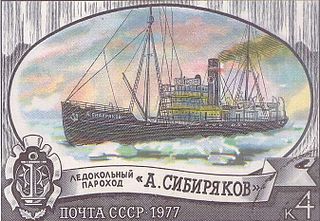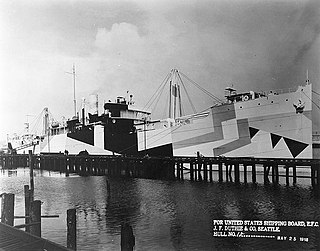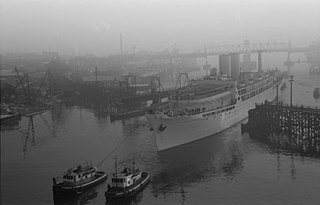See also
- Shipbuilding
- A1 at Lloyd's, the top classification in Lloyd's Register
In shipping, the designation A1 is a symbol used to denote quality of construction and material. [1] In the various shipping registers ships are classed and given a rating after an official examination, and assigned a classification mark, which appears in addition to other particulars in those shipping registers after the name of the ship. In Lloyd's Register the letter represents the quality of the hull, the number the quality of the fitting out.

Lloyd's Register Group Limited, trading as Lloyd's Register (LR), is a technical and professional services organisation and a maritime classification society, wholly owned by the Lloyd’s Register Foundation, a UK charity dedicated to research and education in science and engineering. The organisation dates to 1760. Its stated aims are to enhance the safety of life, property, and the environment, by helping its clients to improve the safety and performance of complex projects, supply chains and critical infrastructure.
A ship classification society or ship classification organisation is a non-governmental organization that establishes and maintains technical standards for the construction and operation of ships and offshore structures. Classification societies certify that the construction of a vessel complies with relevant standards and carry out regular surveys in service to ensure continuing compliance with the standards. Currently, more than 50 organizations describe their activities as including marine classification, twelve of which are members of the International Association of Classification Societies.

Alexander Sibiryakov was a steamship that was built in Scotland in 1909 as Bellaventure, and was originally a seal hunting ship in Newfoundland. In 1917 the Russian government bought her to be an icebreaker. She served the RSFSR and Soviet Union until 1942, when she was sunk by enemy action. The ship gave notable service in the Russian Arctic during the 1930s.

Shin'yō Maru was a cargo steamship that was built in 1894, had a fifty-year career under successive British, Australian, Chinese and Greek owners, was captured by Japan in the Second World War, and sunk by a United States Navy submarine in 1944.

SS Potsdam was a steam ocean liner that was launched in Germany in 1899 for Holland America Line. In 1915 Swedish American Line acquired her and renamed her Stockholm.

Polar Class (PC) refers to the ice class assigned to a ship by a classification society based on the Unified Requirements for Polar Class Ships developed by the International Association of Classification Societies (IACS). Seven Polar Classes are defined in the rules, ranging from PC 1 for year-round operation in all polar waters to PC 7 for summer and autumn operation in thin first-year ice.

SS Cantabria was a Spanish-owned cargo steamship that was built in 1919 in Canada and sunk in 1938 in a naval action in the Spanish Civil War in the North Sea. She was built as War Chief, renamed Alfonso Pérez shortly after she was built, and renamed Cantabria during the Spanish Civil War.

USS West Bridge (ID-2888) was a Design 1013 cargo ship in the United States Navy during World War I. She was begun as War Topaz for the British Government but was completed as West Bridge. After being decommissioned from the Navy, the ship returned to civilian service as West Bridge, but was renamed Barbara Cates, and Pan Gulf over the course of her commercial career under American registry.

Komagata Maru was a cargo steamship that was built in Scotland in 1890, was in German ownership until 1913, and then had a succession of Japanese owners until she was wrecked in 1926. She was launched as Stubbenhuk, renamed Sicilia in 1894, Komagata Maru in 1913 and Heian Maru in 1924.

HMS Port Quebec was a British motor ship that was designed and launched in 1939 to be the refrigerated cargo ship Port Quebec, but completed in 1940 as an auxuiliary minelayer. In 1944 she was converted into an aircraft component repair ship and renamed HMS Deer Sound. In 1947 she was returned to her owner, Port Line, and completed as a cargo ship. She was scrapped in Taiwan in 1968.
The port of Hong Kong is a deep water port located in southern China. It is one of the hub ports serving the South-East and East Asia region, and is a gateway to mainland China. The city of Hong Kong began as a colony of the United Kingdom. It was a free port, and became an international trade center connecting land and sea transport between China and other countries. The port has mature infrastructure and well-developed air-sea-land transport. It helps Hong Kong maintain its position on international trade centre and transshipment hub.

SS Polar Chief was a merchant steamship that was built in England in 1897 and scrapped in Scotland in 1952. In her 55-year career she had previously been called Montcalm, RFA Crenella, Crenella, Rey Alfonso, Anglo-Norse and Empire Chief. Early in the First World War she spent eight months pretending to be the battleship HMS Audacious.
SS Heidberg was a cargo steamship that was built in 1943 in Sweden for a German shipping company. The Allies in 1945 took it for war reparations. She was renamed Empire Convention, and spent about nine months under United Kingdom ownership and management. In 1946 she was transferred to the Soviet Union, who renamed her Эрнст Те́льман – Ernst Thälmann. Her fate is not recorded.

SS Arratoon Apcar was an iron-hulled sail and steam merchant ship that was built in Scotland in 1861 and wrecked off the coast of Florida in 1878. Her wreck in shallow water on Fowey Rocks is now a scuba diving site.
SS Abukir was a British coastal steamship that was launched in 1920 as SS Island Queen and renamed in 1934 as SS Kyle Queen. In 1935 she was renamed Abukir and registered in Egypt. In May 1940 she was torpedoed and sunk in the North Sea while evacuating UK and Belgian soldiers, airmen and civilians from Ostend on the last day of the Battle of Belgium.

HMS Agamemnon was originally the Blue Funnel Line refrigerated cargo ship Agamemnon. She was built in 1929, traded between the United Kingdom and the Far East, and was scrapped in 1963. During the Second World War she was converted into an auxiliary minelayer in 1940, and then into an amenities ship in 1943.

HMS Menestheus was originally the Blue Funnel Line refrigerated cargo ship Menestheus. She was built in 1929, and traded between the UK and the Far East. She was an auxiliary minelayer from 1940 to 1943. In 1945, during the Second World War, she was converted into an amenities ship. She was scrapped in 1953 after being gutted by fire.

HMS Southern Prince was a motor ship that was built in 1929 as the refrigerated cargo ship Southern Prince. She was commissioned into the Royal Navy in 1940 as a minelayer. She became a headquarters ship and then an accommodation ship in 1944, was a fleet training ship in 1945, and returned to civilian trade in 1946. In 1947 she was sold to Italian owners who had her refitted as a passenger ship and renamed her Anna C. From 1952 she was a cruise ship. She was scrapped in 1972.
HMS Teviot Bank was a Bank Line steamship that was built in England in 1938 as the cargo ship Teviotbank. In the Second World War she was a Royal Navy auxiliary minelayer. By 1956 a Panamanian company had bought her and renamed her Nella. She was scrapped in Italy in 1971.
MS Ukraina was one of six Soviet Krim-class ocean liners during the late 1920s built for the Black Sea State Shipping Company. During the Second World War, she participated in the Siege of Odessa in 1941 and the Siege of Sevastopol in 1942. She was sunk by German aircraft in July.